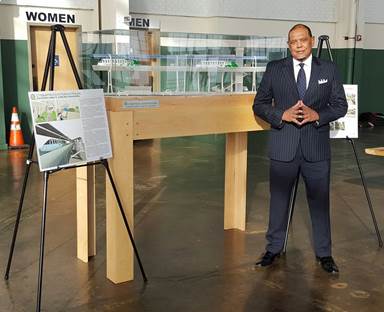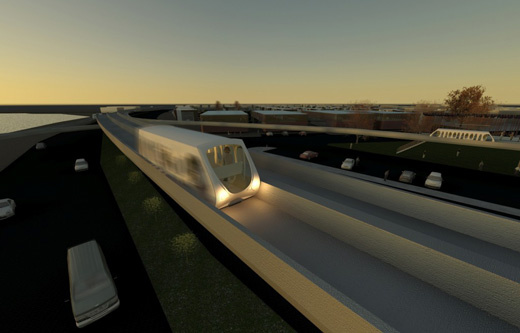If space weapons weren’t enough the RPA is now promoting a space age transportation system that has never been tried, never been built (not even a working model) and has no major backers other than the City of Richmond. There are no employees, no jobs, no manufacturing facility and no buyers.
Like having all employees volunteer for a fiscal haircut to balance the budget, Cybertran seems like a good idea, but it is similarly having trouble getting off the ground. Cybertran is high on promotion but short on substance. Why this is another pet project of the RPA is unclear.
Back in 2011 when the City was flush with Redevelopment money, we paid $20,000 to a lobbyist to try and get federal funding for Cybertran, a private company with a nominal presence in Richmond. There was an MOU between the City of Richmond and Cybertran that promised jobs and production facilities in Richmond if Cybertran ever took off. That was five years ago, and not much has happened.
Cybertran, which touts its Richmond presence, doesn’t even have a Richmond business license. The company is SOS/FTB Forfeited, which means it was forfeited by the Secretary of State and the Franchise Tax Board for failure to meet tax requirements (e.g., failure to file a return, pay taxes, penalties, interest).
Here is what a Bay Area transportation expert wrote about Cybertran:
Here is a post I did to the national transportation leads Listserv about a proposed PRT (Personal Rapid Transit) system in Boston. Also following is an article from my files from when Cybertran was in Alameda. It has many links to articles about PRT systems.
One of the ways in which Cybertran is different is that it uses much larger cars then most PRT systems. Cybertran is proposing 24 passenger "pods "while most other PRT's are 4 to 8 passenger "pods". With a small "pod," a passenger goes to the terminal and gets on the next pod either alone or with a couple of friends and the pod takes them wherever they want to go. There is not the issue of multiple stops at the terminal with different pods going different directions. With a 24 passenger pod there is going to have to be some way to sort out the people who were going various directions, so rather than the pod making the decision and taking the passenger where they want, a passenger going to Bart is going to have to go in the Bart direction 24 person pod and the person going deeper into Lawrence Berkeley Labs two is you have to get into that pod.
This may work for Lawrence Berkeley Labs two if they feel like spending a huge amount of money to get more inflexible service than they can just get with an ordinary bus or, if they wanted to be "green," when the fuel cell bus.
The other issue is regulatory approval. Cybertran is on steel wheels, thus is regulated by the PUC (rubber tires are regulated by the Highway Patrol). The PUC rail folks are incredibly conservative and used to CalTrain style trains. My guess is by the time they come out of the PUC approval process their trains will be quite heavy and quite expensive.
Cybertran’s claims about thousands of jobs assumes that hundreds of different communities around the country are going to adopt this system. I doubt that. A limited system for Lawrence Berkeley labs two would have a few people to build the system and then very few continuing jobs. That's the whole point of these systems. All capital expenditure, no personnel.
PRT is not new. There have been working examples for over 50 years. In the U.S. it became a pet project of Sen. Robert Bird of West Virginia. He put one in Morgantown, the home of West Virginia University. It began running in 1975 and boards about 16,000 people a day. It cost about $130 M for an 8.7 mile (14 km) system. The estimates for expansion are $30 - $40 M / mile. It helps to be a small state with a very senior senator.
In general, around the world, PRT works best in a very large new development. The Docklands development in London was about 8 square miles of former docks and warehouses along the river Thames. That development put in a great deal of rail, including PRT. It would be very difficult to put in a developed area.
As Vinay Pimple laid out last night, other local transportation experts are generally skeptical of Cybertran, believing that the future of transportation will consist of squeezing higher capacities out of existing infrastructure rather than investing in new infrastructure like that required for Cybertran.

Cybertran President Dexter Vizinau,
The item on last night’s agenda (ADOPT a resolution in support of the Cybertran International, Inc. Ultra-Light Rail Transit System (ULRT) and consider co-sponsoring a regional Town Hall Meeting to introduce the ULRT system as a Global Identity Project - Vice Mayor Eduardo Martinez (620-6593) and Councilmember Jovanka Beckles (620-6568), included a resolution designating the Cybertran project as a, “Global Identity Project and co-sponsoring a “Regional Town Hall to introduce the Global Identity Project to the residents of the City of Richmond, West County and Contra Costa County for the purpose of supporting the upcoming Countywide Transportation Tax Measure.” The proposed co-sponsorship would have consisted of the City subsidizing the “town hall” to the tune of $1,500.
If it doesn’t cost the City anything, I have no problem helping Cybertran compete for a grant, but I didn’t think it was right to subsidize a private company to hold an event to promote themselves.
I was also concerned with the misrepresentations Dexter Vizinau of Cybertran continued to repeat. He said that a federal grant had been designated for Cybertran, like the check was in the mail. The fact is that there may an impending federal transportation grant program for which Cybertran may be eligible to compete. Vizinau also said that Cybertran was written into the proposed Contra Costa Transportation Authority new sales tax measure. That assertion is simply false. Vizinau is long on claims and short on facts.
After Vizinau agreed to remove the request for funding, I voted with the rest of the Coty Council for the City to be a “co-sponsor” of the town hall, which costs the City nothing. I hope City staff makes Cybertran take out a business license before the co-sponsorship becomes formal.
Tom Butt, Mayor
City Council To Discuss Support Of Local Elevated Rail System Company Tuesday
Bay City News Service
Published 8:23 pm, Monday, June 20, 2016
RICHMOND (BCN)
The Richmond City Council on Tuesday will consider adopting a resolution to support a local company and its new elevated rail system that it touts as environmentally friendly and uniquely adaptable.
City leaders will consider co-sponsoring an upcoming regional town hall meeting during which Richmond-based CyberTran International Inc. will introduce its rail system to residents.
The company is developing and manufacturing a programmable elevated rail system that runs on solar power, a system the company refers to as Ultralight Rail Transit.
"(The) system is not only being designed here in Richmond, it will be manufactured here as well, generating hundreds of well-paying manufacturing jobs for Contra Costa County residents," CyberTran CEO Dexter Vizinau said in a statement
The company's officials said Richmond leaders have been working to help facilitate the system being built and deployed in the city.
The system is included in a proposal to connect the Richmond Parkway Transit Center with locations on the city's waterfront, the site of planned residential development.
The company invited the public to hear a discussion of the rail system at the City Council meeting at 6 p.m. Tuesday at 440 Civic Center Plaza.
Richmond City Council To Consider Solar-Powered Elevated Rail System
June 20, 2016 8:29 PM

(CyberTran International)
RICHMOND (CBS SF) — The Richmond City Council on Tuesday will consider adopting a resolution to support a local company and its new elevated rail system that it touts as environmentally friendly and uniquely adaptable. company and its new elevated rail system that it touts as environmentally friendly and uniquely adaptable.
City leaders will consider co-sponsoring an upcoming regional town hall meeting during which Richmond-based CyberTran International Inc. will introduce its rail system to residents. to residents.
The company is developing and manufacturing a programmable elevated rail system that runs on solar power, a system the company refers to as Ultralight Rail Transit. refers to as Ultralight Rail Transit.
“(The) system is not only being designed here in Richmond, it will be manufactured here as well, generating hundreds of well-paying manufacturing jobs
 for Contra Costa County residents,” CyberTran CEO Dexter Vizinau said in a statement. for Contra Costa County residents,” CyberTran CEO Dexter Vizinau said in a statement.
The company’s officials said Richmond leaders have been working to help facilitate the system being built and deployed in the city.
The system is included in a proposal to connect the Richmond Parkway Transit Center with locations on the city’s waterfront, the site of planned residential development.
The company invited the public to hear a discussion of the rail system at the City Council meeting at 6 p.m. Tuesday at 440 Civic Center Plaza. |

